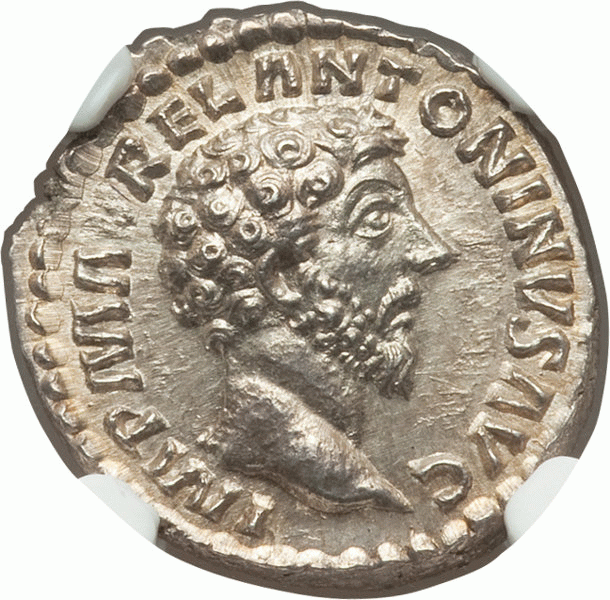Denarius of Marcus Aurelius, “Philosopher King”
Marcus Aurelius served as the emperor of Rome from 161 to 180 A.D. His 19-year reign was marked by military conflict and a series of disasters, including a plague that devastated Rome. Despite these challenges, the coins he minted reflect military victories and a quest for peace, highlighting the use of coins as propaganda in the ancient world.

Philosopher King
Emperor Antoninus Pius “adopted” Marcus Aurelius and groomed him as his successor. He also arranged for Marcus to marry his daughter, Faustina. When he ascended to the throne, Marcus Aurelias named his adopted brother, Lucius Verus, his co-emperor.
Often referred to as the “Philosopher King,” Marcus Aurelius is remembered most for his writing on self-improvement and the Stoic philosophy. He wrote his famous Meditations during his many military campaigns. The series of 12 books was likely intended for his own, personal reflection rather than publication. However, Meditations is regarded as one of the most important philosophical writings of the time and remains relevant today.
According to historians, Marcus Aurelius practiced what he preached. “Alone of the emperors, he gave proof of his learning not by mere words or knowledge of philosophical doctrines but by his blameless character and temperate way of life,” wrote historian Herodian.
Marcus Aurelius was deified by decree of the Senate upon his death in 180 A.D. His biological son Commodus succeeded him. However, his reign was far less successful, with the death of Marcus Aurelius regarded as the end of the Pax Romana (Roman Peace). The column Commodus constructed to memorialize Marcus Aurelius still stands in Rome.
Denarius of Marcus Aurelius
While Marcus Aurelius minted several coins during his reign, the denarius was the most common. As the standard silver coin of the Roman Empire, it was used for trading by merchants and to pay Rome’s vast military.
As with other Roman emperors, the designs changed over time. On most coins, the obverse featured the bust of Marcus Aurelius. In some coins, his head is bare, and he is clean shaven. In others, he is depicted with a beard, with a laureate on his head.
The reverse of the denarius varied more significantly. On some coins, the success of his co-emperorship is commemorated, featuring the inscription CONCORDIA AUGUSTORUM (“harmony of the emperors”) around the standing figures of the two brothers clasping hands. Other coins showed the Roman goddess Felicitas. She is standing holding a long caduceus and scepter.
